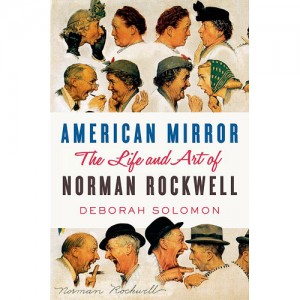 As I sat in the back of the Leon Levy Center for Biography yesterday, unforunately blocked by a number of white haired ladies and gentleman, I couldn’t help but ask this question to myself: who was Norman Rockwell? The name rang a bell but I still didnt know who he was. I was hoping I would learn more about his life and to my expectations, I did. Maybe a little too much I think.
As I sat in the back of the Leon Levy Center for Biography yesterday, unforunately blocked by a number of white haired ladies and gentleman, I couldn’t help but ask this question to myself: who was Norman Rockwell? The name rang a bell but I still didnt know who he was. I was hoping I would learn more about his life and to my expectations, I did. Maybe a little too much I think.
The event consisted of a conversation betwen art journalist Judith H. Dobrzynski and art critic Deborah Solomon, the author of American Mirror: The Life and Art of Norman Rockwell. Ms. Dobrzynski asked questions about Rockwell’s life, artwork, and her inspiration for writing this book. Ms. Solomon admitted that before she wrote the book, she had no interest in Rockwell’s life. It wasn’t until she looked at his work and realized its mysteriousness and his love for people that she become obsessed with him. She used the internet and ancestry.com to find the information for her biography and used interviews from Rockwell’s sons. She also analyzed his artwork and discussed their meaning to the audience.
I learned four things from the conversation
– Rockwell was obsessed with the human figure. He was not interested in landscapes at all. A majority of his workwork depicts a gaze on a particular person or object. Unlike Dutch paintings where most people looked away from one another, Rockwell’s paintings had figures looking at a particular object or person. Rockwell looked at people carefully with his gaze because he loved faces and figure paintings.
– Solomon was treated at the Austin Riggs center in Massachusetts. He was treated by Erik Erickson, the second to best known psychologist behind Sigmund Freud. In most of his sessions, he would complain about his wife. He said that he would kill himself if this wife had to go with him anywhere outside of the city.

– Solomon said that in most biographies, theres a blame on the mother rather than the father. I can’t dispute this claim since I haven’t read alot of biographies. But I can see this could be the case. No offense (lol). Solomon said Rockwell blamed and disliked his mother because she was a hypochroniac and took the attention of his father away from his kids. He disliked her so much that when he would paint or draw illustrations, he would either leave her out or put her in the background. Rockwell’s Thanksgiving painting below depicts this dislike. The lady in the white hair showing only the face is his mother.
– Rockwell displayed homoerot ic tendencies in his paintings. His 1968 painting The Runaway is an example of his love for men.
ic tendencies in his paintings. His 1968 painting The Runaway is an example of his love for men.
Solomon said that in most of his paintings, he would have two kinds of men or boys: a stronger more rugged man and a skinny boy. He felt empowered when he was able to identy with a manly figure, which could mean he had self esteem issues. Drawing two men of different proportions brought Rockwell emotional warmth. He enjoyed the male face and beauty as opposed to female beauty, which he drew unfrequently.
Overall, I was able to see Rockwell not as just a painter, but as a person who had joy, love for people, and problems. Not to say we all don’t have problems but his unique eye for art makes him a very interesting figure to learn more about.


 ic tendencies in his paintings. His 1968 painting The Runaway is an example of his love for men.
ic tendencies in his paintings. His 1968 painting The Runaway is an example of his love for men.
